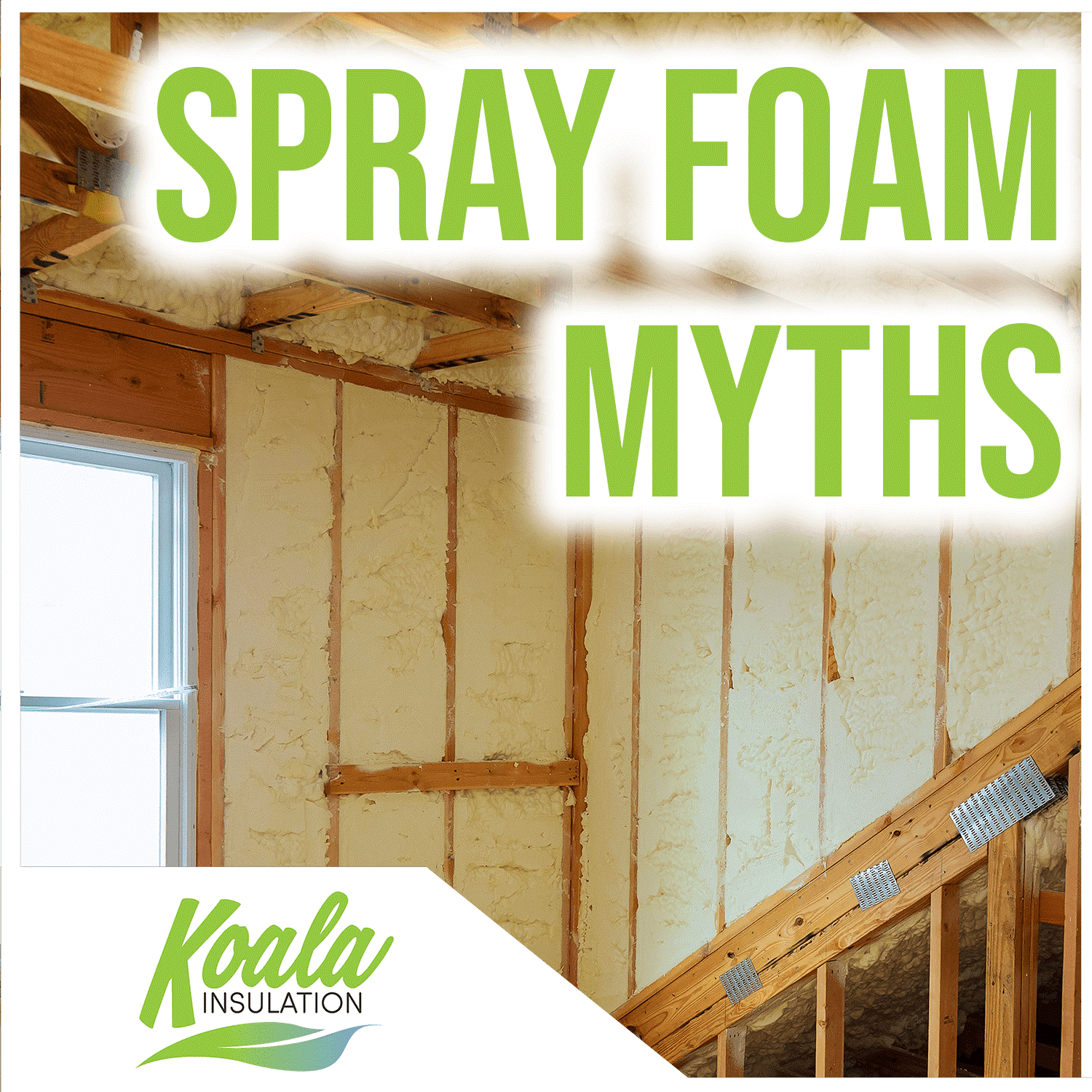
The Top 5 Spray Foam Myths in Northwest South Carolina
When you’re taking the time to choose the right insulation, you may initially feel overwhelmed by the various choices with their own benefits and drawbacks. You're looking for a material that's going to help the building more than it can potentially damage it, right? Well, unfortunately, you might run into a number of myths that are parroted by worried homeowners that don't look into the facts of certain materials. Here are a few common spray foam myths our insulation experts at Koala Insulation of Greenville can debunk or explain!
What is Spray Foam Insulation
Installed on walls, ceilings, and even under some floors, spray foam is a commonly-used insulator and strong air sealant. You have two types to choose from when considering a spray foam installation: open-cell and closed-cell. Open-cell, which is often used in warmer climates, is noticeable by its bubbly and cloud-like appearance. Closed-cell, on the other hand, is more dense and rigid, which is also what makes it a quality vapor barrier.
There are two main chemicals that are mixed on-site and then sent through a host into the stud cavities of your home. They react and bond together on contact with the surface in order to create a long-term barrier. If you have spray foam insulation applied throughout your home, it’s important to ensure you have a well-trained and certified professional to make sure these chemicals are properly balanced, safely applied, and completely set and dry before allowing anyone to enter the house without personal protective equipment (PPE).
5 Myths About Spray Foam Insulation
The chemicals that are mixed together in order to create spray foam insulation could be hazardous to those that are untrained to handle them. However, this is primarily as separate components; once the chemicals have been mixed properly, applied, and dried on the surface, the chemicals are no longer a health threat as they do their job.
Koala Insulation of Greenville’s insulation experts are trained at Koala’s headquarters in Melbourne. Once they pass their training, the team works together to make sure every job is treated with care and specialty. One way they go through extensive measures to ensure there are reduced health risks is by letting the foam sit for up to 24 hours before anyone reenters the home.
2. Closed-Cell Spray Foam is a Better Choice
Closed-cell spray foam has a number of advantages, including its high R-value with an average of R-6.9 per inch of depth. Because of this value, many homeowners and even some industry contractors see this type of spray foam insulation as the better choice. The R-value is the measurement of how effectively the material can reduce the rate of heat transfer.
However, it’s important to note that each type of spray foam insulation has its own benefits. The differences are applied to each home’s specific needs, which include everything from the climate to the regular household habits. For example, open-cell spray foam is often considered better for pest prevention, sound absorption, and warmer climates. Meanwhile, the high R-value of closed-cell spray foam means it generally takes less material to help regulate the temperature throughout a building.
While closed-cell spray foam may be the better choice for your home’s needs, it doesn’t necessarily mean it’s a “one size fits all” solution in every case. Talking with your local insulation professionals can reveal what type of insulation material works best in the various areas of your house.
3. Spray Foam is a New Insulation Material
If you haven’t heard of spray foam insulation, it’s no surprise - it wouldn’t necessarily be the first thing many homeowners picture when they think of insulation. However, it’s actually been used in commercial and residential buildings since the 1980s!
This type of insulation is most often applied in between the beams of your walls and the joists of your ceiling. When taking a trip to your attic or around the basement, keep an eye open for exposed insulation - you may be surprised to find some already installed in your home! You can even find spray foam installed on the roof of certain buildings to help prevent water and heat damage.
The next time you enter a commercial building with an exposed ceiling, take a look upward. It's likely you may see a colored-over, bubbly texture above you. This is a spray foam finish that has most likely been covered in intumescent paint (learn more about this important covering later in this article!)
4. Spray Foam Insulation is Very Expensive
We may have tricked you - this is more of a half-truth! Spray foam can be more expensive than other types of insulation material. However, the major difference is that it has one of the best return on investment rates due to its longer lifespan, coverage capabilities, and reduced material usage.
When other “more common” types of insulation are installed in a building, they usually have to be updated more often than spray foam. This is what makes the chemical mixture a better alternative thanks to its long lifespan. Energy Star estimates that homeowners can save around 20% on heating and cooling when insulation and air sealants are installed, adding to the cost-benefit of spray foam for an average of 15 years.
So, although spray foam tends to cost more than some of the easily recognizable materials, it depends on what kind of project, the surface area, and your view on recouping costs. When you take into account the return on investment opportunity, it’s easily one of the less expensive materials to have installed.
5. Spray Foam is Highly Flammable
Although it's a fact that all smoke is toxic, there is a common fear among homeowners that spray foam could be extremely flammable and toxic because of the chemicals used. It is true that spray foam can be flammable if not coated with a flame retardant. The material isn't inherently fire-resistant.
However, the material is almost always covered with an intumescent coating. By painting this coating over the spray foam, it provides an additional fire safety measure. Just like other materials have fire-resistant additives, such as cellulose, the intumescent coating is used to reduce potential hazards.
Intumescent coating is a barrier that is even commonly used in construction to cover flammable objects. The paint is more than likely used in some parts of your own home already! It’s typically applied when the building is first under construction. Therefore, it’s a commonly used fire safety additive, reducing the chance for spray foam to present a fire hazard to your home.
Consult Your Local Insulation Experts
One of the most misunderstood and under-researched insulation materials is spray foam. Not only does it cost more than a majority of other options, but the idea of mixing chemicals inside the house is also a red flag for some families and homeowners with health conditions. While spray foam comes with a few warnings and considerations, these aren't necessarily any different than your other options.
Koala Insulation of Greenville has a certified crew that understands there are spray foam myths that may worry some homeowners; we’re here to not only cover a few of the most common but provide facts and reassurance that this is a safe and reliable product to install in your home. To learn more about how spray foam insulation could improve the comfort and safety of your home, contact Koala Insulation of Greenville today
Ready to book your free insulation evaluation?
We have 3 convienant ways for you to get in touch
We Provide Insulation Services to the Following Greenville Areas
DUNCAN, LANDRUM, LYMAN, GREENVILLE, GREER, TAYLORS, EASLEY, TRAVELERS REST, BELTON, FOUNTAIN INN, MAULDIN, PELZER, PIEDMONT, SIMPSONVILLE, WILLIAMSTON
Counties Served
SPARTANBURG, GREENVILLE, PICKENS, ANDERSON, LAURENS
Zip Code
29334, 29356, 29365, 29615, 29650, 29651, 29687, 29601, 29605, 29607, 29609, 29611, 29613, 29614, 29617, 29640, 29642, 29690, 29627, 29644, 29662, 29669, 29673, 29680, 29681, 29697

